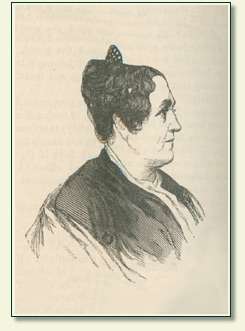Almira Hart Lincoln Phelps

Almira Hart Lincoln Phelps, née Hart (July 15, 1793 – July 15, 1884) was an American educator and author during the 19th century. Phelps published several popular[1] science textbooks in the fields of botany, chemistry, and geology.[2]
Life
Almira Hart was born on July 15, 1793, in Berlin, Connecticut. She was the youngest child in her family, growing up in an intellectual, independently thinking, and religious environment.[1]
One of her most inspirational mentors of her life was her older sister Emma Hart Willard. While living with her sister, she was also mentored by John Willard and three of his fellow students who also came to live in the Willard household. She studied mathematics and philosophy.[3]
At the age of 16, Almira Hart began her teaching career in district schools. She later continued her own education. In 1814, she opened her first boarding school for young women at her home in Berlin; and two years later, she became principal of a school in Sandy Hill, New York.[1]
In 1817, Hart married Simeon Lincoln and left her career for six years to be a housewife and mother to her three children. After her husband’s untimely death in 1823, she returned to the education world as Almira Hart Lincoln. She became a teacher and vice-principal at the well-known Troy Female Seminary in Troy, New York. While teaching at the Female Seminary, her interests in science increased, and her botanical career began under the influence of Amos Eaton. While under the direction of Eaton, she found her passion in botany and the lack of introductory text books for secondary and beginning college level students. This led Phelps to write and publish her first and most famous textbook in 1829, Familiar Lectures on Botany.[1]
In 1830, with the absence of her sister, Almira Hart Lincoln was acting as principal of the Troy Female Seminary and gave a series of lectures related to female education that she would later publish as her second book, Lectures to Young Ladies. She remarried in 1831 to John Phelps, a lawyer and politician from Vermont. Taking the name Almira Hart Lincoln Phelps, she once again gave up her career to raise a second family. While raising her family, she continued to write new textbooks on chemistry, natural philosophy, and education.
With each new publication and her continuing teaching lectures, Phelps’s fame grew, and she was asked to head many female seminaries. In 1838, she accepted the challenge and moved to West Chester, Pennsylvania, to be head of the seminary there. She stayed at West Chester for one year, and then headed to Rahway, New Jersey, for two years. Finally, Phelps ended in Ellicott's Mills, Maryland in 1841, where she accepted a position as principal of the Patapsco Female Institute, a post she held for fifteen years before retiring in 1856. The Institute offered academic courses in history, geography, literature, languages, mathematics, sciences, and the arts.[4]
In 1859, Phelps was the third woman elected as a member of the American Association for the Advancement of Science. After gaining her membership, Phelps continued to write, lecture, and revise her textbooks until she died in Baltimore on her 91st birthday, July 15, 1884.[1]
Publications
- Familiar Lectures on Botany (1829)
- Dictionary of Chemistry (1830)
- Botany for Beginners (1831)
- Geology for Beginners (1832)
- Female Student; or, Fireside Friend (1833)
- Chemistry for Beginners (1834)
- Lectures on Natural Philosophy (1835)
- Lectures on Chemistry (1837)
- Natural Philosophy for Beginners (1837)
- Hours With My Pupils (1869)
- Caroline Westerly (1833)
- Ida Norman (1850)
- Christian Household (1860)
References
- 1 2 3 4 5 ED Rudolph (1984). "Almira Hart Lincoln Phelps (1793–1884) and the Spread of Botany in Nineteenth Century America". American Journal of Botany. 71 (8): 1161–1167. doi:10.2307/2443392. JSTOR 2443392.
- ↑ Mariolina Rizzi Salvatori. Pedagogy: Disturbing History, 1820–1930. p. 95. ISBN 978-0-8229-5822-2.
- ↑ Pnina Abir-Am and Dorinda Outram (1987). Uneasy Careers and Intimate Lives: Women in Science(1789–1970).
- ↑ Isabella Margaret Elizabeth Blandin. History of Higher Education of Women in the South Prior to 1860. p. 173.
- ↑ IPNI. A.Phelps.